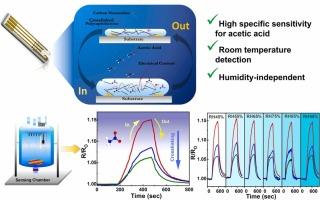优化交联的层次化结构PCL/CNT纳米复合材料用于醋酸的耐化学检测
IF 3.7
1区 化学
Q1 CHEMISTRY, ANALYTICAL
引用次数: 0
摘要
本研究报道了交联聚己内酯/碳纳米管(cPCL/CNT)纳米复合材料作为醋酸的耐化学传感器。复合材料表现出极低的渗透阈值(ϕc = 0.002),电导率跨越12个数量级。三甲基丙烷三丙烯酸酯(TMPTA)诱导的交联产生了层次化结构,其特点是交联密度具有自限性和非单调结晶度,当TMPTA为12.wt %时,其峰值为45%。优化后的传感器(2.5 wt% TMPTA)具有高灵敏度(134%响应/%)、良好的线性(R²= 0.98)、宽分析范围(0.004-0.418%)和稳定的循环性能。所有传感实验均在环境条件(25±2°C, ~55% RH)下进行,而湿度耐受性则通过改变室内湿度(45-95% RH)来确定。在较高的交联密度(> 7.5% TMPTA)下,由于柔韧性降低,灵敏度逐渐下降。传感机制涉及醋酸吸收破坏碳纳米管网络,交联密度严格调节基质刚度和分析物可及性之间的平衡。接触角测量揭示了分析物接触后的显著润湿性转变(从76.9°到14.7°),突出了通过与PCL羰基的氢键对乙酸的特殊选择性。重要的是,这些纳米复合材料解决了呼吸分析仪未满足的要求,在不同湿度条件下(45-95% RH)保持稳定的性能,因此在工业监测和呼吸分析应用中具有强大的潜力。本文章由计算机程序翻译,如有差异,请以英文原文为准。

Hierarchically structured PCL/CNT nanocomposites with optimized crosslinking for chemiresistive detection of acetic acid
This study reports crosslinked polycaprolactone/carbon nanotube (cPCL/CNT) nanocomposites as chemiresistive sensors for acetic acid. The composites show an exceptionally low percolation threshold (ϕc = 0.002) with conductivity spanning twelve orders of magnitude. Trimethylolpropane triacrylate (TMPTA)-induced crosslinking yields a hierarchical structure characterized by a self-limiting crosslink density with non-monotonic crystallinity, peaking at 45 % for 12.5 wt% TMPTA. The optimized sensor (2.5 wt% TMPTA) exhibits high sensitivity (134 % response/%), excellent linearity (R² = 0.98) across broad analytical range (0.004–0.418 %), and consistent cyclic performance. All sensing experiments were performed under ambient conditions (25 ± 2°C, ∼55 % RH), while humidity tolerance was confirmed by varying chamber humidity (45–95 % RH). Sensitivity progressively declined at higher crosslinking densities (>7.5 wt% TMPTA) due to reduced flexibility. The sensing mechanism involves acetic acid absorption disrupting the CNT network, with crosslinking density critically modulating the balance between matrix rigidity and analyte accessibility. Contact angle measurements reveal dramatic wettability transitions upon analyte contact (from 76.9° to 14.7°), highlighting the exceptional selectivity toward acetic acid through H-bonding with PCL carbonyl groups. Importantly, these nanocomposites address the unmet requirements of breath analyzers, maintaining robust performance under varying humidity conditions (45–95 % RH), and thus hold strong potential for industrial monitoring and breath analysis applications.
求助全文
通过发布文献求助,成功后即可免费获取论文全文。
去求助
来源期刊

Sensors and Actuators B: Chemical
工程技术-电化学
CiteScore
14.60
自引率
11.90%
发文量
1776
审稿时长
3.2 months
期刊介绍:
Sensors & Actuators, B: Chemical is an international journal focused on the research and development of chemical transducers. It covers chemical sensors and biosensors, chemical actuators, and analytical microsystems. The journal is interdisciplinary, aiming to publish original works showcasing substantial advancements beyond the current state of the art in these fields, with practical applicability to solving meaningful analytical problems. Review articles are accepted by invitation from an Editor of the journal.
 求助内容:
求助内容: 应助结果提醒方式:
应助结果提醒方式:


